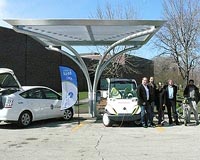 |
Hannover, Germany (SPX) Apr 06, 2011 Magnesium instead of steel - this could be an option for lightweight car body parts. A car door made of magnesium is roughly 50 percent lighter. This is one of the exhibits drawn from along the automobile manufacturing chain that researchers at the Fraunhofer AutoMOBILE Production Alliance are showcasing at the Hannover Messe, April 4-8 (Hall 2, Stand D22). Lighter, more economical, more reasonably priced - that is the motto. If possible, equipped with electric drive, too. Carmakers have lots of demands to meet. Researchers at the Fraunhofer AutoMOBILE Production Alliance help carmakers meet these demands, and the developments they are working on include lightweight car components. They are presenting the results of their work at the Hannover Messe in the form of a "glass car."
A car door made of magnesium By way of comparison: the version in steel weighs some 10.7 kilos (about 23.5 lbs). Of all substances, though, why magnesium? "Magnesium is available in large quantities worldwide, it can be molded, and for similar structures - a car door, for instance - it has virtually the same properties as steel. "For example, it has a comparable rigidity" summarizes Soren Scheffler, group manager at IWU. "We have developed specific molding technologies for wrought magnesium alloys. This makes the lightweight material available for future use in series production of car bodies." How can the quantities of materials used be reduced? What recyclable materials offer a long-term supply and are candidates for reduction? And what resource-saving technologies and plant technologies offer adequate potential for the future? In all, the researchers will be showcasing around 40 new developments - and thus an excerpt of the entire production chain, from the planning stages to the complete and painted vehicle. "Our displays focus on the themes of a car's body, powertrain, interior, vehicle assembly, methodological competence and production research for electromobility," explains Alliance coordinator Lars Koch.
Slide-ground tumbled alloy wheel rims As one would with sand paper, manufacturers begin with coarse abrasive media and replace this with finer and finer abrasives over several steps. While slide-grinding is a conventional technology, to date it has lacked clear specifications: what frequency must be used to stimulate the abrasive media? How does one move the wheel rim through the process? What geometries and shapes of abrasive media are best suited to the task? Researchers at the Fraunhofer Institute for Production Systems and Design Technology IPK in Berlin are now investigating the theoretical connections and making a systematic record of them.
New adhesive technologies Conventional adhesives need several hours before they are hardened through humidity - and the headlight has to be held in place throughout this period. "We use an adhesive that is also heat-hardening," notes Dr. Skupin, a researcher at IFAM. "We heat it locally using a microwave antenna, and within one minute the adhesive has hardened and assembly can continue." The new adhesive is already ready for use in industry.
The Fraunhofer AutoMOBILE Production Alliance Thanks to the thematically complementary areas of research focus of the individual institutes, innovations can be implemented quickly, holistically and sustainably along the entire process chain for automobile production. The alliance takes on challenges in environmental policy, such as fuel and CO2 reduction, electromobility and reductions in the use of material. At the same time, it considers the economic aspects involved, such as the permanent pressures to cut costs. The alliance's offices are located at the Fraunhofer IWU in Chemnitz.
Share This Article With Planet Earth
Related Links Auto at Fraunhofer Car Technology at SpaceMart.com
 Mobile With Electricity
Mobile With ElectricityHannover, Germany (SPX) Apr 06, 2011 Electric cars are cleaner, quieter and more efficient than gasoline- or diesel-powered vehicles. Even so, they have not yet caught on. Now, however, a new era is beginning: the era of electric mobility. Experts from Fraunhofer are making important contributions to this. A selection of the research projects is being presented at the Hannover Messe trade fair). If electric vehicles are to be ... read more |
|
| The content herein, unless otherwise known to be public domain, are Copyright 1995-2010 - SpaceDaily. AFP and UPI Wire Stories are copyright Agence France-Presse and United Press International. ESA Portal Reports are copyright European Space Agency. All NASA sourced material is public domain. Additional copyrights may apply in whole or part to other bona fide parties. Advertising does not imply endorsement,agreement or approval of any opinions, statements or information provided by SpaceDaily on any Web page published or hosted by SpaceDaily. Privacy Statement |